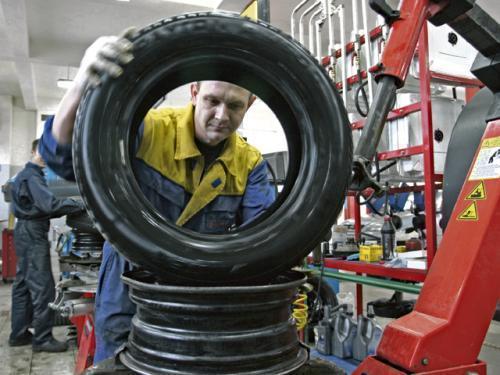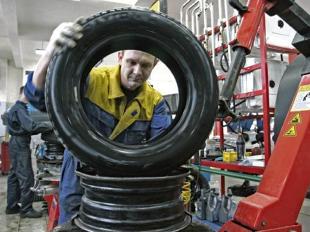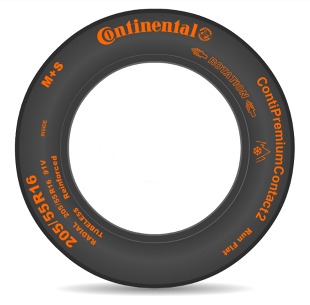
Tire markings. How to read them?
 Each tire has a series of numbers and symbols on the sidewalls. These are signs that inform the user about the type, structure and other characteristics of a given product.
Each tire has a series of numbers and symbols on the sidewalls. These are signs that inform the user about the type, structure and other characteristics of a given product.
 The information stored on the tire makes it possible to identify it and allows it to be adapted to a given type of vehicle. The most important tire markings are size, speed index and load index. There is also a marking informing about the winter properties of the tire, its performance characteristics (approval, sidewall reinforcement, rim protection edge, etc.). One of the most important tire markings is the DOT number. This tire designation indicates the date the tire was manufactured (read by the last four digits of the DOT number).
The information stored on the tire makes it possible to identify it and allows it to be adapted to a given type of vehicle. The most important tire markings are size, speed index and load index. There is also a marking informing about the winter properties of the tire, its performance characteristics (approval, sidewall reinforcement, rim protection edge, etc.). One of the most important tire markings is the DOT number. This tire designation indicates the date the tire was manufactured (read by the last four digits of the DOT number).
In addition, the marking of tires covers, in particular, the method of installation on wheels. The fact is that directional tires are mounted in the direction of travel (marking the direction of rotation), and asymmetrical tires are mounted on the corresponding side in relation to the passenger compartment (internal / external marking). Proper tire installation is key to safe tire use.
The trade name of the product is also displayed next to the tire designation on the sidewall of the tire. Each tire manufacturer uses the names according to their scheme and marketing strategy.
Bus ciphertext
Each tire has a specific size. Given in this order: tire width (in millimeters), profile height expressed as a percentage (this is the ratio of the sidewall height of the tire to its width), R is the designation of the radial design of the tire and the rim diameter (in inches) on which the tire can be installed. Such an entry might look like this: 205 / 55R16 - a tire with a width of 205 mm, with a profile of 55, radial, rim diameter 16 inches.
Other important information for the user is the speed limit index for which the tire is designed and the maximum load index. The first value is given in letters, for example T, that is, up to 190 km / h, the second - with a digital designation, for example 100, that is, up to 800 kg (details in the tables).
The production date of the tire is also important, as it is represented as a four-digit code representing the week and year of manufacture, for example, 1114 is a tire manufactured in the eleventh week of 2014. According to the Polish standard PN-C94300-7, tires can be freely sold for three years from the date of production.
 What do the symbols on the tires mean?
What do the symbols on the tires mean?
All word designations and abbreviations used in tire labeling come from the English language. Here are the most common characters (in alphabetical order):
BasePen – the bus is electrostatically grounded
COLD – information for measuring tire pressure on cold tires
DOT – (Department of Transportation) Tire properties meet all US Department of Transportation safety standards. Next to it is the XNUMX digit tire identification code or serial number.
DSST – Dunlop RunFlat tire
ESE, well, well - abbreviation of the Economic Commission of Europe, means European approval
EMT – (Extended Mobility Tire) Tires that keep you moving after losing pressure
FP – (Fringe Protector) or RFP (Rim Fringe Protector) tire with rim coating. Dunlop uses the MFS symbol.
FR - a tire with a rim designed to protect the rim from mechanical damage. Most often found in tires with a profile of 55 and below. The FR marking is not displayed on the tire sidewall.
G1 – tire pressure monitoring sensor
INSIDE – this side of the tire must be installed inward, facing the car
JLB – (Jointless Band) nylon endless belt
LI – Indicator (load index) showing the maximum load capacity of the tire
LT – (Light Truck) Mark indicating that the tire is for 4×4 vehicles and light trucks (used in the USA).
MAX - maximum, i.e. maximum tire pressure
M + S - a symbol identifying winter and all-season tires
Outside – a sign indicating that the tire must be mounted on the outside of the vehicle is visible from the outside
P – The symbol (Passenger) is placed in front of the tire size. Indicates that the tire is designed for passenger cars (used in the USA)
PAX – Zero pressure Michelin tire with stable inner ring
PSP-Beta - the tire has a structure characterized by overlapping in such a way as to reduce the noise level.
R – (Radial) radial arm
GO – retreaded tire
RF – (Reinforced = XL) tire with increased load capacity, also known as reinforced tyre.
RFT - Run Flat Tires, a Run Flat tire that allows you to continue driving after a tire failure, used by Bridgestone, Firestone, Pirelli.
Rim protector – the tire has solutions that protect the rim from damage
ROF – (Run On Flat) A symbol used by Goodyear and Dunlop to designate tires that allow you to continue driving after a tire failure.
TURN – tire rolling direction
RKK - Run Flat System component, opposite Run Flat Bridgestone type
SST – (Self-Sustaining Technology) A tire that allows you to continue driving after a puncture when the inflation pressure is zero.
SI – (Speed index) designation indicating the upper limit of the allowable speed of use
TL – (Tubeless Tire) tubeless tire
TT – Tube type tires
TV – location of tire tread wear indicators
SVM – the tire has a design in which aramid cords are used
XL – (Extra Load) tire with a reinforced structure and increased load capacity
ZP - Zero Pressure, on Typu Run Flat Michelina
Speed Ratings:
L = 120 km / h
M = 130 km/h
N = 140 km / h
P = 150 km / h
Q = 160 km/h
R = 170 km/h
S = 180 km/h
T = 190 km / h
H = 210 km / h
V = 240 km/h
W = 270 km/h
Y = 300 km/h
ZR = 240 km/h with maximum load
EU labels
 From November 1, 2012, every tire manufactured after June 30, 2012 and sold in the European Union must have a special sticker containing the most important information about the safety and environmental aspects of the tyre.
From November 1, 2012, every tire manufactured after June 30, 2012 and sold in the European Union must have a special sticker containing the most important information about the safety and environmental aspects of the tyre.
The label is a rectangular sticker attached to the tire tread. The label contains information about the three main parameters of the purchased tire: economy, grip on wet surfaces and the noise generated by the tire while driving.
Economy: seven classes are defined, from G (least economical tyre) to A (most economical tyre). Economy may vary depending on vehicle and driving conditions.
Wet grip: seven classes from G (longest braking distance) to A (shortest braking distance). The effect may vary depending on the vehicle and driving conditions.
Tire noise: one wave (pictogram) is a quieter tire, three waves is a noisier tire. In addition, the value is given in decibels (dB).
